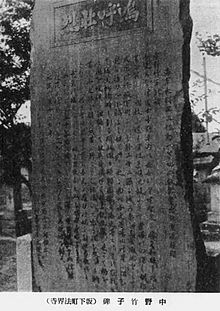Nakano Takeko
Nakano Takeko ( 中 野 竹子, * 1847 ; † October 10, 1868 ) was a Japanese fighter from the Principality of Aizu who fought and died during the Boshin War. Nakano was born in Edo , in the Hoshina Matsudaira residence of the Aizu Matsudaira clan, as the daughter of Nakano Heinai, an Aizu official. She was trained in martial arts and literary arts and was adopted by her teacher Akaoka Daisuke . She then worked as a teacher in her adoptive father's school. In 1868 she first arrived in Aizu. Tomoe Gozen was a role model for her .
During the Battle of Aizu she fought with a naginata (a Japanese polearm ) and was the leader of an ad hoc force of female fighters who fought independently of the male Aizu followers because they were not allowed to fight as part of the official troops. The army was later referred to as the Women's Army ( 娘子 隊Jōshitai ).
While she was conducting an attack against the troops of the Principality of Fürgaki (from Mino , now Gifu ) fighting on the side of the Satsuma Chōshū Restoration Army, which was loyal to the emperor , she was fatally shot in the chest. Instead of leaving her head to the enemies as a trophy, she asked her sister to sever the head and bury it. The sister brought the head to the Hōkai temple (in today's Aizubange, Fukushima ) and buried it under a pine tree.
A memorial was erected for them in the Hōkai Temple. The Japanese admiral Dewa Shigeto was involved in the construction of the monument.
During the Aizu Autumn Festival, a group of young girls dressed in Hakama and Shiro headbands hold a procession to commemorate the deeds of Nakanu and her fellow campaigners.
Legend has it that she killed 172 samurais.
literature
- Michael Hoffman: Women warriors of Japan . In: The Japan Times . October 9, 2011.
- Chris Kincaid: Japan's Warrior Women . August 9, 2015. (incl. "The Women's Army - the Joshigun ")
- Smithsonian Institution : Samurai Warrior Queens . 2015.
- Kallie Szczepanski: Images of Samurai Women . April 1, 2017.
Web links
- The Last Woman Samurai . In: Womankind . # 3, February – April 2015.
- Samurai Warrior Queens TRAILER . Urban canyons. YouTube .
Individual evidence
- ↑ 会 津 「中 野 竹子」 情報 - 【会 津 物語】. Retrieved December 25, 2018 (Japanese).
- ↑ Yamakawa Kenjirō; Munekawa Toraji (1926). Hoshū Aizu Byakkotai jūkyūshi-den . Wakamatsu: Aizu Chōrei Gikai. pp. 63-64.
- ^ A b ZDF: ZDF History: The Last Samurai Warrior. ZDF, accessed on December 25, 2018 .
- ↑ Hoshi Ryōichi (2006). Onnatachi no Aizusensō . Tokyo: Heibonsha. p. 80.
- ↑ Yamakawa Kenjirō; Munekawa Toraji (1926). Hoshū Aizu Byakkotai jūkyūshi-den . Wakamatsu: Aizu Chōrei Gikai. p. 69.
| personal data | |
|---|---|
| SURNAME | Nakano, Takeko |
| BRIEF DESCRIPTION | Japanese women fighters of the Aizu era |
| DATE OF BIRTH | 1847 |
| DATE OF DEATH | October 10, 1868 |


